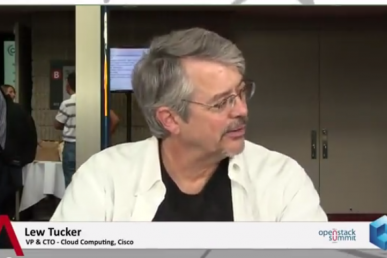This article follows an earlier post about the 2014 OpenStack Summit, where Lew Tucker, the CTO of cloud computing at Cisco, outlined his vision for a Web of many Openstack clouds.
Tucker also took a few moments towards the end of his talk to delve into Cisco’s corporate strategy as it relates to Openstack, which we think is worth relaying more widely. Herein lie a few key concepts that apply to every corner of the OpenStack world.
Culture: Review, Review, Review
At Cisco, like many others, Stackalytics is used to see to how many contributors there are in the company, and who is contributing to which projects. Tucker said that, looking at the data, it’s clear that Cisco needs the most help in reviewing code.
Improving and extending code review was a big focus for Cisco in 2014 out of necessity, but Tucker sees their commitment as an ongoing advantage, too.
“What I’m really proud of is that we’ve been able to move the number of reviewers we have up in our organization," he said. "Reviewing other people’s code is an essential part of what we do. Importantly, it’s the best way to learn the code, in addition to improving it.”
But for Tucker, code review improves more than just the code.
Specifically, putting a big emphasis on code reviews among its OpenStack team has helped Cisco grow (instead of buy) talent. It’s how you get the best OpenStack developers.
“You don’t hire them, you build them. You grow them. You have to get people in your own organization reviewing other people’s code. That is where they learn OpenStack and they can provide a contribution very early in the process, and that’s worked very well for us.”
A Must: Getting Users Involved Directly
Tucker also talked a lot about the importance of getting Cisco’s own customers and partners involved in OpenStack, instead of positioning them as mere recipients of technology.
Certainly, Cisco wants to bring OpenStack solutions to their customers and partners on Cisco infrastructure, with faster times-to-production and less hassle overall. Convenience and ease of use are always differentiators. To this end, Cisco recently acquired Metacloud, which will help them deliver OpenStack as a service — running OpenStack on-prem, but remotely managing it.
But what was novel was hearing Tucker talk passionately about how getting customers and partners to take an active part in the community is essential to their OpenStack strategy. He doesn’t think that more and more ergonomic product offerings should translate to a passive, decidedly “managed” mentality.
To the contrary, Tucker sees that community participation increases the depth of any customer engagement, increases success rates and ROI, and creates new opportunities for innovation. It’s something that Cisco fiercely advocates for, and measures.
“What I’m most proud of, in truth, is the fact that [our customers and partners] are up on stage this week," Tucker said. "They have joined the community. We really do not want ours to be a traditional vendor-customer relationship, where we ship hardware with software and that’s it. We want them involved in the community because that’s what’s going to be important to continue to move things forward in all the right ways.”
Vision: What’s Next for Networking?
Of course, Cisco is ultimately a networking company.
Beyond his efforts to build a review-centric culture, Tucker is understandably current on software-defined networking and so-called overlays and underlays.
But he and Cisco are also putting a lot of resources into longer-term, transformative potentials, thinking on a decades-long timeframe (which is one element that makesTucker’s talks so consistently interesting).
“Networking below OpenStack is in a huge, huge shift right now,” he said. “With SDN everybody’s talking about overlays and underlays. But before that we were talking about IPV6 and whether IPV6 can be used.”
Indeed, we’re seeing huge shift after huge shift, and the rate of change (9 times out of 10 for the better) does not look to abate anytime soon.
So what’s next? Tucker hinted at what Cisco is exploring right now:
“For example, we have a larger address space. Should we be using that larger address space to create more logical networks based on segmenting that address base, using some kind of flow-based isolation? This might be a really important concept going forward. At the same time, things such as containment are important, that we’re meaningfully participating there as well.”
Tucker also talked about the growing cadre of scenarios in which OpenStack makes good business sense. To his mind, we’re seeing a Cambrian explosion of clouds so to speak, made possible by strong open source communities and a deep commitment to interoperation.
“Cloud computing is turning into all of these different ways of delivering what we used to think of as just…cloud. We can deliver it in a public cloud. We can deliver it as a private cloud or on an on-premise cloud, all for a wide variety of applications, including IT. Even a lot of management is now moving to the cloud, even though you’re managing things back inside of an IT organization. That’s another area that I think is important in terms of planning for the future.”
Tucker knows that Cisco must be architected to accommodate all these scenarios without flinching, and prepared organizationally to execute against ever-evolving customer requirements across each. To him and to many others, we’re still in the early innings of a considerably longer game, a point he emphasized several times throughout.
Transition: Becoming a Cloud Provider
Before ending his session, Tucker talked about Intercloud Fabric, around which there has been a lot of buzz lately. Intercloud Fabric is a key part of Cisco’s strategy moving forward.
Intercloud Fabric is a hybrid overlay cloud model by which, from an enterprise data center, you can extend a cloud offering onto Amazon, Azure or OpenStack. This is Cisco’s first step to becoming a cloud provider themselves.
“But the track that we’re taking is slightly different than others,” Tucker insisted. “We’re doing this with our partners. We’re providing OpenStack technology at a number of different major service providers throughout the world, whether they are in Europe, or they’re in Latin America, or any place else. They will be able to have Cisco-run clouds sold through their own sales channel. They will be selling these services, and on the backend they will be run by Cisco, running on OpenStack.”
This obviously represents a significant change for Cisco, and the users it supports. It is a change we can all see coming, but it was interesting to hear from Tucker the particular tact the networking giant will take as a point of market entry for what sounds like a more and more ambitious project by the day.
To learn more, check out Lew Tucker’s full talk at the OpenStack Summit in Paris here:
Image: bgpPeeringMap
- Demystifying Confidential Containers with a Live Kata Containers Demo - July 13, 2023
- OpenInfra Summit Vancouver Recap: 50 things You Need to Know - June 16, 2023
- Congratulations to the 2023 Superuser Awards Winner: Bloomberg - June 13, 2023

)










